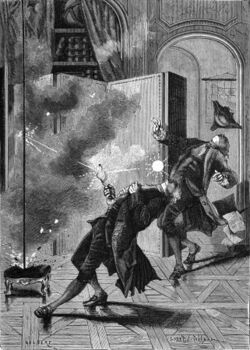Georg Wilhelm Richmann
Topic: Biography
 From HandWiki - Reading time: 2 min
From HandWiki - Reading time: 2 min
Georg Wilhelm Richmann (Russian: Георг Вильгельм Рихман) (22 July 1711 – 6 August 1753), (Old Style: 11 July 1711 – 26 July 1753) was a Russian Imperial physicist of Baltic German descent. He proved that thunder clouds contain electric charge.
He was born in the city of Pernov (today Pärnu, Estonia) in Swedish Livonia, which in 1721 became part of the Russian Empire as a result of the Great Northern War (1700–1721). His father died of plague before he was born, and his mother remarried. In his early years he studied in Reval (today's Tallinn, Estonia); later he studied in Germany at the universities of Halle and Jena.
In 1741, he was elected a member of the St. Petersburg Academy of Sciences. He did pioneering work on electricity and atmospheric electricity, and also worked on calorimetry, in doing so collaborating with Mikhail Lomonosov. Richmann also worked as a tutor to the children of Count Andrei Osterman. In 1741, he translated Alexander Pope's Essay on Man into German from French.
He was electrocuted in St. Petersburg while "trying to quantify the response of an insulated rod to a nearby storm." He was attending a meeting of the Academy of Sciences, when he heard thunder. The Professor ran home with his engraver to capture the event for posterity. While the experiment was underway, a supposed ball lightning appeared and collided with Richmann's head leaving him dead with a red spot on his forehead, his shoes blown open, and parts of his clothes singed. An explosion followed "like that of a small Cannon" that knocked the engraver out, split the room's door frame, and tore the door off its hinges.[1][2] Reportedly, ball lightning traveled along the apparatus and was the cause of his death.[2][3] He was apparently the first person in history to die while conducting electrical experiments.[4]
References
- ↑ On 6 August 1753, the Swedish scientist Georg Wilhelm Richmann was electrocuted in St. Petersburg while trying to quantify the response of an insulated rod to a nearby storm. The incident, reported worldwide, underscored the dangers inherent in experimenting with insulated rods and in using protective rods with faulty ground connections. [1]
- ↑ 2.0 2.1 Clarke, Ronald W. (1983). Benjamin Franklin, A Biography. Random House. p. 87. ISBN 978-1-84212-272-3. https://archive.org/details/benjaminfranklin00clar_0/page/87.
- ↑ "Frenchman Thomas François D'Alibard used a 50-foot (15 m) long vertical rod to draw down the "electric fluid" of the lightning in Paris on May 10, 1752. One week later, M. Delor repeated the experiment in Paris, followed in July by an Englishman, John Canton. But one unfortunate physicist did not fare so well. Georg Wilhelm Reichmann attempted to reproduce the experiment, according to Franklin's instructions, standing inside a room. A glowing ball of charge traveled down the string, jumped to his forehead and killed him instantly - providing history with the first documented example of ball lightning in the process." Krider, E. Philip (2006). "Benjamin Franklin and Lightning Rods". Physics Today (American Institute of Physics) 59 (1): 42–48. doi:10.1063/1.2180176. Bibcode: 2006PhT....59a..42K. http://physicstoday.org/journals/doc/PHTOAD-ft/vol_59/iss_1/42_1.shtml. Retrieved 3 December 2012.
- ↑ Physicists create great balls of fire - fundamentals - 07 June 2006 - New Scientist
 KSF
KSF

